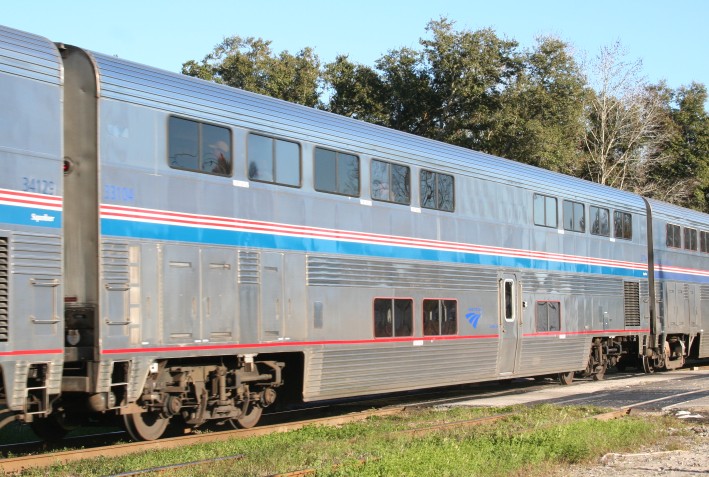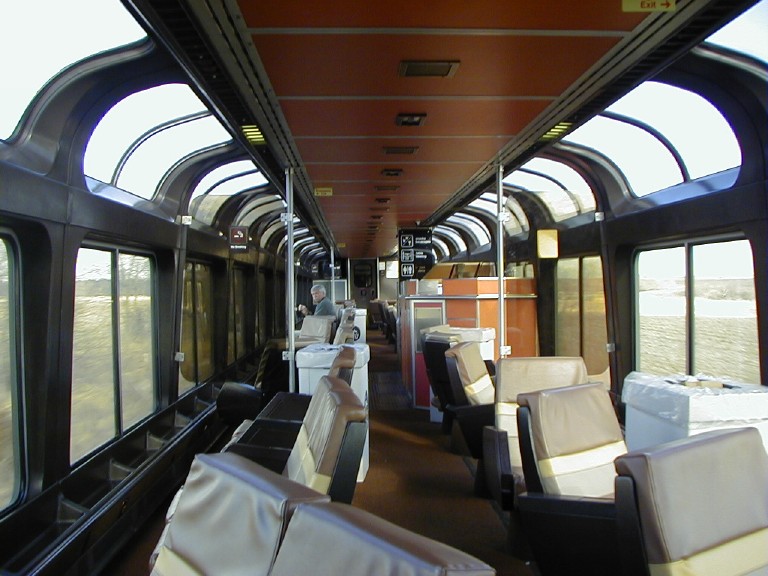- Superliner (railcar)
Infobox Train
background =
name = Superliner

imagesize = 250px
caption = Superliner I Dining Car
interior
interiorcaption = Interior of Superliner I Lounge Car
Manufacturer =Pullman Standard (Series I) /Bombardier Transportation (Series II)
Factory =
Family =
Refurbishment =
Replaced =
Formation =
Designation =
Operator = Amtrak
Depots =
LinesServed = Most Amtrak trains west ofMississippi River , theCity of New Orleans , the Capitol Limited, and occasional substitutions on Michigan trains.
yearconstruction =1978-81, 1993-95
yearservice =
yearscrapped =
numberconstruction =
numberbuilt = 479cite web
url=http://www.trainweb.org/web_lurker/AmtrakSuperliner/
title=Amtrak Superliner
publisher=www.trainweb.org
accessdate=2008-03-26]
numberservice = 413
numberscrapped = 22
CarBody =
CarLength = 85 feet 0 inches (25.9 m)
CarWidth = 10 feet 2 inches (3.1 m)
CarHeight = 16 feet 2 inches (4.9 m)
floorheight =
platformheight =
entrylevelorstep = Step
art-sections =
doors =
MaxSpeed = 100 mph (161 km/h)
Weight = 148,000 lb (67 tonnes) gross weight for coaches (all specs [cite web
url= http://www.tsb.gc.ca/en/reports/rail/1999/r99s0100/r99s0100.asp
title= Crossing Collision/Derailment VIA Rail Canada Inc. Passenger Train No 85 Mile 33.54, Goderich-Exeter Railway (GEXR) Guelph Subdivision Limehouse, Ontario
accessdate= 2008-02-28
date= 1999-11-09
format= HTML
publisher=Transportation Safety Board of Canada
language= English] )
Capacity = 74 maximum
Auxiliaries =
Power-supply =Head end power
Gauge =
Brakes =The Superliner is a double decker passenger car used by
Amtrak on long haul trains that do not use theNortheast Corridor . The initial cars were built byPullman-Standard in the late 1970s and a second order was built in the mid 1990s byBombardier Transportation . As delivered, the cars came in various configurations, including coach, diner, and sleeper.History
When money was made available for Amtrak to acquire new cars, plans were made to acquire bi-level cars based on the 1956 Budd-built "El Capitan" Hi-Levels operated by the Santa Fe Railway (which were purchased by Amtrak when formed in 1971).cite book
last = Solomon
first = Brian
title = Amtrak
publisher = MBI Publishing Company
url=http://books.google.com.au/books?id=313LC1TljQMC&pg=RA1-PA132&lpg=RA1-PA132&dq=superliner+amtrak+history&source=web&ots=toX4YiFNkb&sig=D3aceN3QZPnXS5PK7fGkFLxhixw&hl=en#PRA1-PA132,M1
year = 2004
page = page 129
isbn = 0760317658 ] The initial order of 235 Superliner I cars was placed with Chicago coachbuilderPullman Standard on April 2 1975, later being increased to 284 cars for $241 million in total. The first car was delivered in October 1978, and they made their debut on the Chicago - Milwaukee service onFebruary 26 1979 . [Citation
publication-date = 1979-06
date = 1979
year = 06
periodical = Trains
publication-place = Milwaukee, Wisconsin, USA
publisher = Kalmbach] The coaches were the first cars delivered, so it was not until October 28, 1979 that the first Superliner equipped long haul train ran, the westbound "Empire Builder" from Chicago to Seattle. The last car of the order, a sleeper, was delivered at the end of July 1981 and also the last car ever built by Pullman and was named in honor of the Company's founder,George Mortimer Pullman .When the Superliners began to arrive in the late 1970s, many Hi-Level coaches were converted into Coach-Dorms for crew use on Superliner trains. These were replaced in the 1990s by new Superliner II Transition Sleepers. In recent years, five "El Capitan" lounge cars were refurbished as the "Coast Starlight's" "
Pacific Parlour " first-class lounge cars. These cars have a service bar, booths, and chairs on the upper level, and were recently upgraded to have a theatre on the lower level. All other Hi-Level cars are off the company's active roster.The Superliner II fleet of 140 cars was built in 1993-94 at a cost of $340 million by
Bombardier inBarre, Vermont ,cite book
last = Solomon
first = Brian
title = Amtrak
publisher = MBI Publishing Company
year = 2004
page = page 132
url=http://books.google.com.au/books?id=313LC1TljQMC&pg=RA1-PA132&lpg=RA1-PA132&dq=superliner+amtrak+history&source=web&ots=toX4YiFNkb&sig=D3aceN3QZPnXS5PK7fGkFLxhixw&hl=en#PRA1-PA132,M1
isbn = 0760317658 ] who acquired the designs and patents from Pullman in 1987. The introduction of these new cars permitted the use of Superliner cars on east coast routes such as the "Capitol Limited" and "AutoTrain".Design
The Superliners were the first Amtrak car type to be equipped with an on-board waste treatment and disposal system linked to all
toilets . Initially the cars could not be worked east of Chicago due to limited overhead clearances, but by the 1980s many eastern railroads had raised clearances on their tracks to permit tri-level auto-carriers and double stack container trains, which also permitted the operation of the Superliners.The Superliner I and Superliner II differ somewhat in interior fittings, [cite web
url=http://www.trainweb.com/accommod/super1.htm
title=Differences Between Superliner I and II Cars
publisher=www.trainweb.com
accessdate=2008-03-26] primarily in color - the newer cars tend toward gray, aquamarine, and salmon rather than the shades of brown and orange favored on earlier cars. Externally, the two classes differ in a number of subtle respects, but they are readily distinguished by the type of truck (bogie) used to support the car: Superliner I cars use a German design originally fitted with an air bag suspension (replaced with springs), while the Superliner II cars use a General Steel Castings truck of the same type used under Horizon,Viewliner , and the original self-propelled 1969Metroliner cars.Sleeping car
Two configurations exist for Superliner sleeping cars. Of the 125 sleeping cars, 119 are configured as below, and the remaining 6 cars are configured with all Bedrooms on the upper level.
* Upper level:
** 5 Bedrooms (formerly known as "Deluxe Bedrooms")
** 10Roomette s (formerly known as "Superliner Standard Bedrooms" and "Economy Bedrooms")
** 1 shared toilet for Roomette passengers
** Car-to-car passage
* Lower level:
** 1 Family Bedroom (entire width of the car)
** 1 Accessible Bedroom (entire width of the car)
** 4 Roomettes
** 3 shared toilets for Roomette and Family Bedroom passengers
** 1 shared shower
** luggage racks
** vestibule (unlike single-level passenger cars with a vestibule at each end of the car, a "Superliner"' s single lower-level vestibule is in the center of the car)Dining car
Superliner dining cars have almost the entire upper level available for seating, while the galley (kitchen) occupies the entire lower level. A dumbwaiter is used to bring food to the dining level, as well as to return
dishes andcutlery for washing. Amtrak operates 69 Superliner dining cars.Lounge
When originally delivered in the 1970s, Superliner I lounges were referred to as "Lounge Café" cars. These were fitted with enormous windows that wrapped upward into the ceiling, providing views of scenery along the train's route. With the arrival of Superliner II cars in the 1990s, the nomenclature for all Superliner lounges with large windows became "Sightseer Lounge". In addition to the 50 Sightseer Lounges, five lounge cars were converted from Superliner I dining cars for Auto Train service; these cars, which are only found in that train, lack the larger windows of the Sightseer Lounge cars.
Superliner lounge cars once had an operating wet-bar on the upper level. This function has been consolidated with that of the snack bar on the lower level, but the abandoned upper-level bars have not yet been removed. Recently, this space has been reactivated during peak periods on the
Empire Builder route, but only to serve light snacks like pretzels and soda. On other routes, the bar may be used as a speaking podium for volunteer National Park Service rangers from the Trails and Rails program. The rest of the upper level is filled with a mixture of swivelling chairs and love seats facing the windows.Coach
102 Superliner I coaches were built, and 48 Superliner I coach-baggage combination cars with a secure baggage hold instead of lower-level seating. 38 Superliner II coaches were added to the roster.
The "normal" Superliner coaches have 12 seats downstairs in addition to the 62 seats upstairs. The lower level coach seating is handicapped accessible (with actual space for a wheelchair or two) and is a special reservations category (with no additional charge). The coach-bag combination coaches naturally have only upstairs seating. On the lower level in all coaches there are large luggage racks and, typically, four unisex toilets (one with a changing room), an accessible toilet, and a dedicated women's restroom.
Superliner coach seating is highly unlike airplane coach-class seating. Superliner coaches have wide two-and-two reclining seats, with foot-rests and retractable leg-rests. The 50-inch "pitch" (distance from one seat-back to the next) of the seats makes for very comfortable and commodious seating, but puts the foot-rests out of reach of many passengers. There are overhead open luggage racks but they are not suitable for bulky objects.
30 of the coach-baggage combinations were later converted into "smoking coaches" with a smoking lounge replacing the baggage area and the outside baggage door in the side of the car sealed shut. Since all Amtrak trains are now non-smoking throughout (with the exception of Auto Train), all coach smoking cars were converted back to coach baggage cars. At least one train, the Texas Eagle, already uses a coach-bag in lieu of a stand-alone baggage car. Another train, the "Coast Starlight", uses a converted standard coach as a special "Arcade Car", occupied downstairs by arcade games and token machines and upstairs by coach seats, it was formerly the "Kiddie Car". Of the 188 coaches of various types originally delivered, 159 are "in service" [late 2006] , the remainder either wrecked and scrapped or wreck-damaged and awaiting either repairs or scrapping.
Transition Sleeper
A number of "transition sleeper" cars were built for use on Superliner-equipped trains. Transition cars have been used in the past to connect single level cars with Superliner or high level cars on rare occasions. High level Coach-Dorms were the predecessors to the current Superliner transition dorms and had a coach section.
These cars feature roomette accommodations for members of the train crew (although occasionally used for passengers) on the upper level, and a handicapped bedroom and crew lounge on the lower level. Sanitary facilities (toilets and showers) are on the upper and lower levels, along with the standard center vestibule. The "transition" in the name refers to the fact that these cars have a high-level end door and diaphragm only at one end; the other end has a short staircase from the upper level leading to an end door at the height of standard single-deck railcar end doors. Theoretically, this could be used to allow passengers passage from single-level to Superliner cars in a single train; in practice, it is only used to allow the crew on-the-road access to the older, single-level
baggage car s used on many Superliner trains.Amtrak California
In 1990 California passed propositions 108 and 116 drastically expanding funding for intercity rail within the state. With this new source of money, the state set out to specify a standardized railcar for the state that would be suitable for both intercity and commuter rail operations. The result of this effort were designs for two variations of the Superliner. While the commuter rail version was never built, 88 cars of the intercity version were built.cite web
url=http://www.amtrakcalifornia.com/rail/go/amtrak/all_aboard/amtrak-california-locomotives-and-cars/index.cfm
title=Amtrak California - Amtrak California Locomotives and Cars
publisher=www.amtrakcalifornia.com
accessdate=2008-03-26] The most visible difference between the Superliner and the "California Car" is that the California Cars have 2 doors per side instead of one on the Superliners. The first California Cars (8000 series) were built by Morrison-Knudsen and were delivered in 1996, the remainder (6000 series) were built by Alstom and delivered in 2000 and 2001. In 2007, Caltrans accepted delivery of 2 rebuilt Superliners which had been damaged in accidents for use in Amtrak California service. These cars are painted in the Amtrak California scheme and have had their interiors rebuilt to a more modern appearance. Caltrans is currently rebuilding more Superliners, and recently added another to the Amtrak California fleet. The state of California is planning to order an additional 36 California Cars in 2008 or 2009.References
External links
* [http://hebners.net/amtrak/ Amtrak Photo Archives]
* [http://homepage.mac.com/wkaemena/FSPanos/Menu418.html/ Superliners inside and outside in QTVR and Flash ( virtual reality)]
* [http://www.banksofthesusquehanna.com/MMsuper.html Comparison of the varied types and liveries of Superliner railcars]
Wikimedia Foundation. 2010.
